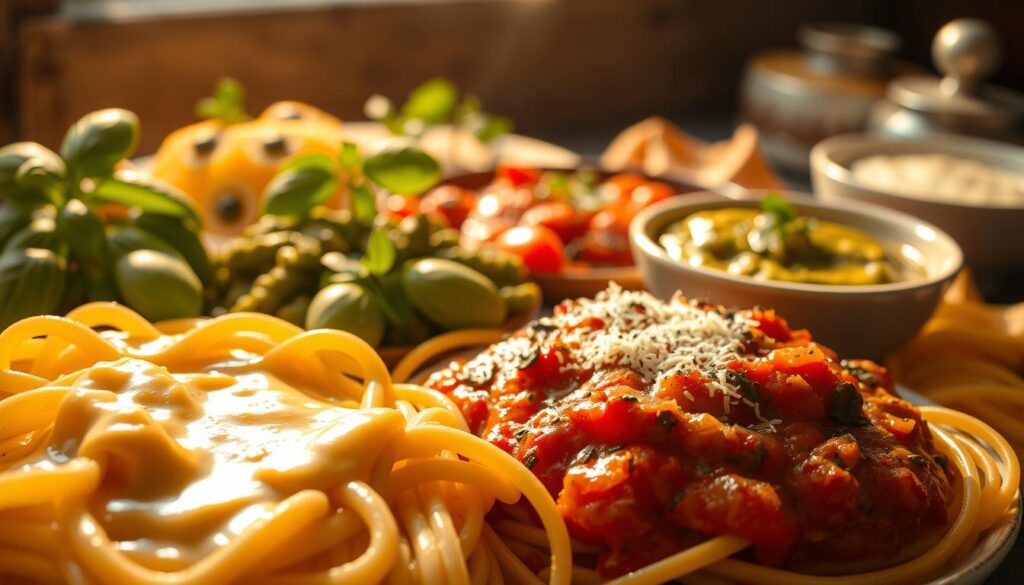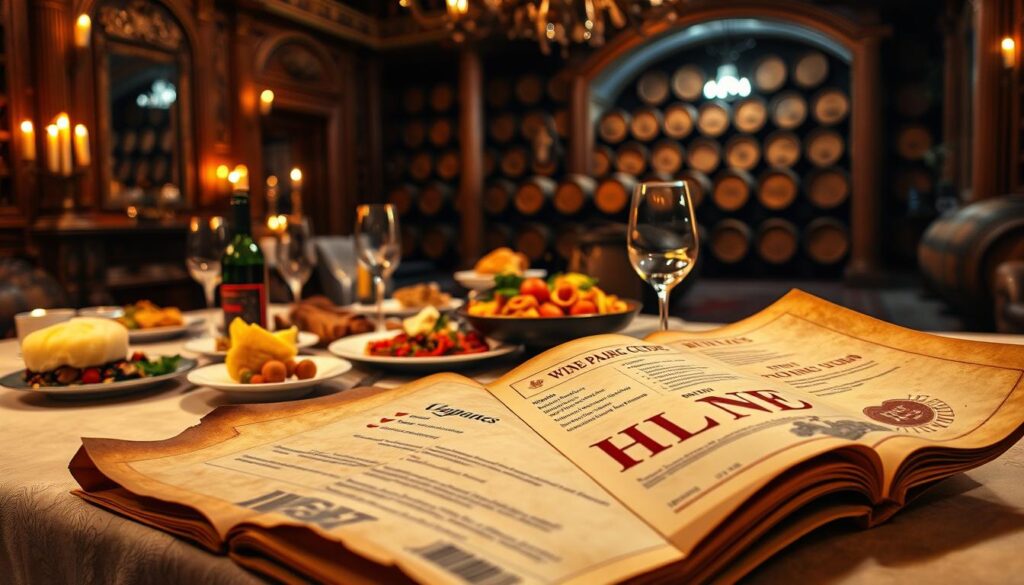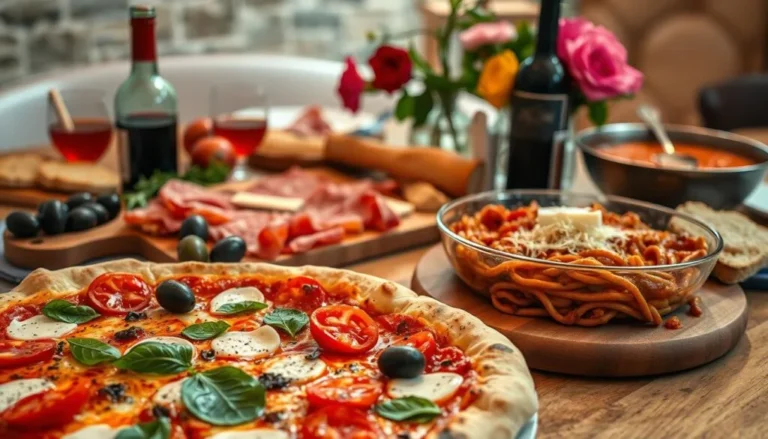Walking through Rome’s cobblestone streets, I caught the scent of fresh pasta and sauces. It was like stepping into a world of flavors. Roman cuisine is not just food; it’s a story of generations, filled with family traditions and innovation.
Roman recipes weave a tapestry of tastes that show the heart of Italian cooking. From lively trattorias to cozy family kitchens, Roman food celebrates simplicity and quality. These classic recipes will let you taste Rome’s true flavors, whether you love cooking or just enjoy trying new dishes.
Exploring Roman cuisine means diving into a mix of tradition and creativity. Each dish shows the city’s rich history, from ancient times to today’s culinary trends. Your adventure through these recipes will connect you to Rome’s culinary soul.
Key Takeaways
- Roman recipes celebrate simple, high-quality ingredients
- Traditional cooking techniques are fundamental to authentic flavors
- Each dish tells a story of cultural heritage
- Roman cuisine emphasizes fresh, seasonal produce
- Cooking is a form of family connection and storytelling
Table of Contents
Introduction to Roman Cuisine
Roman cuisine is a tale of creativity from simplicity. It comes from cucina povera (poor people’s cooking). These recipes turn simple ingredients into amazing dishes that have won hearts for centuries.
The essence of ancient Roman cooking is making great dishes with little. Exploring Roman cuisine, you’ll see a world where every ingredient counts. Nothing is wasted.
What Makes Roman Recipes Unique?
Roman cuisine is special for several reasons:
- It focuses on local, seasonal ingredients
- It keeps preparation simple
- It highlights natural flavors
- It’s clever with what it has
Key Ingredients in Roman Cooking
To understand Roman cuisine, you need to know its key ingredients. The basics are:
- Pecorino Romano cheese
- Guanciale (cured pork cheek)
- Fresh seasonal vegetables
- Local grains and legumes
Cooking Techniques You Should Know
Roman cooking values simplicity and respects ingredients. It uses slow simmering, wood-fire roasting, and minimal seasoning. These methods keep the true flavors alive, just like generations before.
“In Roman cooking, less is always more.” – Ancient Roman Culinary Wisdom
Iconic Roman Dishes to Try
Roman cuisine is known for its simple yet flavorful dishes. These traditional roman dishes have been perfected over centuries. They show the passion and respect for local ingredients that Roman cooking is all about.
Rome is famous for its four classic pasta dishes. Each dish has a story of tradition, technique, and local ingredients passed down through generations.
Cacio e Pepe: A Cheese and Pepper Delight
Cacio e Pepe is one of Rome’s oldest dishes. It’s made with just three ingredients:
- Tonnarelli or spaghetti pasta
- Pecorino Romano cheese
- Freshly ground black pepper
The secret is in the creamy sauce made with pasta water and cheese. It turns simple ingredients into a masterpiece.
Carbonara: The Creamy Comfort Food
Carbonara is a beloved dish in Rome. National Carbonara Day is celebrated on April 6th. It’s made with five key ingredients:
- Pasta (traditionally spaghetti)
- Guanciale
- Egg yolks
- Pecorino Romano cheese
- Black pepper
It’s a hearty dish, with a serving size of 400 to 600 calories.
Amatriciana: A Saucy Tradition
Amatriciana is known for its bold flavors. It’s made with bucatini, tomatoes, guanciale, and Pecorino Romano cheese. This dish comes from Amatrice and is a favorite in Roman trattorias.
“Rome’s most famous dishes are often reduced to a trio: cacio e pepe, amatriciana, and carbonara.” – Roman Culinary Experts
These dishes are more than just food. They are a part of Roman culinary heritage. They invite you to taste the rich flavors of Italy’s eternal city.
Exploring Roman Appetizers
Roman cuisine is known for its delicious appetizers. These starters show off Rome’s rich food history. They mix simple ingredients with skillful cooking.
Appetizers are a great way to start exploring Roman food. They introduce you to the area’s amazing tastes. Let’s look at some famous starters that will excite your taste buds.
Supplì: Rice Balls of Delight
Supplì are a beloved street food in Rome. These crispy rice balls are filled with mozzarella and fried until golden. For years, street vendors have been serving these tasty treats.
- Crispy exterior with a molten cheese center
- Typically made with leftover risotto
- Popular as a quick snack or appetizer
Carciofi alla Romana: Roman-Style Artichokes
Artichokes are a big deal in Roman food. The Carciofi alla Romana recipe involves stuffing artichokes with fresh herbs like mint, garlic, and parsley.
| Ingredient | Preparation Method |
|---|---|
| Artichokes | Split and cleaned |
| Herbs | Mint, garlic, parsley |
| Cooking Method | Steamed in olive oil, white wine, water |
Prosciutto e Melone: A Classic Starter
Prosciutto e Melone is a simple yet elegant dish. It pairs thin slices of salty prosciutto with sweet melon. This combination is a perfect balance of flavors.
- Requires high-quality prosciutto
- Best served chilled
- Represents the Italian approach to simple, fresh ingredients
Traditional Roman Sauces
Roman cuisine is known for its amazing sauces. These sauces turn simple foods into works of art. They show the heart of Roman cooking, telling stories of culture and history through their flavors and making methods.

Roman sauces are more than just ingredients. They hold generations of cooking wisdom. They show the creativity and resourcefulness of Italian cooking.
Sugo all’Amatriciana: A Flavor Explosion
Sugo all’Amatriciana comes from shepherds in Lazio’s mountains. It’s a sauce that went from simple to beloved. It’s a true taste of Roman cooking.
- Key Ingredients:
- 500g Bucatini pasta
- 250g Guanciale
- 500g Peeled tomatoes
- 120g Pecorino Romano
Sugo di Caccia: Hunter’s Sauce Traditions
Sugo di Caccia comes from Roman hunting traditions. It connects today’s kitchens with ancient cooking ways. Its strong flavors remind us of hunters’ hearty meals.
Pesto Romano: A Unique Basil Blend
Pesto Romano is different from its Genovese version. It shows the creative side of Roman food history. It uses local ingredients and old cooking methods.
| Sauce | Key Characteristics | Primary Ingredients |
|---|---|---|
| Amatriciana | Spicy and rich | Guanciale, tomatoes, pecorino |
| Sugo di Caccia | Rustic and hearty | Wild herbs, game meat |
| Pesto Romano | Aromatic and unique | Local basil, herbs, cheese |
Each sauce has its own story of Roman cooking innovation. They invite you to dive into the rich world of traditional Roman cooking.
Roman Desserts: Sweet Endings
Roman cuisine is not complete without its amazing desserts. These sweet treats are more than just food. They celebrate Roman culture and culinary art.
Exploring traditional Roman dishes shows a world of incredible sweetness. These desserts have delighted people for generations. Let’s look at the most iconic Roman desserts that will take you to Italy’s heart.
Tiramisu: The Coffee Indulgence
Tiramisu is a beloved classic in Roman cuisine. It has layers of espresso-soaked ladyfingers and rich mascarpone cream. Its name literally means “pick me up”, showing the energizing mix of coffee and sweet cream.
- Espresso-dipped ladyfingers
- Creamy mascarpone filling
- Dusting of cocoa powder
Maritozzo: Sweet Cream-Filled Buns
Maritozzo are big, leavened sweet buns that are a cherished tradition. They are filled with lightly sweetened whipped cream. They also have delightful extras like:
- Pine nuts
- Raisins
- Candied orange peel
Historically, maritozzo played a unique role in Roman courtship, with young men presenting these sweet buns to their potential brides.
Pastarelle Laziali: Pastry Delights
Pastarelle are delicate pastries from the Lazio region. They show the baking skills of Roman pastry chefs. These small pastries have creative flavors and textures.
Whether you love desserts or are a culinary explorer, these Roman desserts are a delicious trip through Italy’s sweet culinary world.
Modern Twists on Roman Classics
Roman cuisine is getting a fresh spin. Chefs and home cooks are updating classic recipes with new techniques and ideas. This movement brings a creative burst to roman cuisine, keeping its heritage alive and appealing to today’s tastes.
Today’s chefs are reimagining traditional roman dishes. They’re making bold new versions that stay true to the original flavors but also introduce new twists.
Creative Takes on Carbonara
The classic carbonara is getting a modern update. Chefs are adding unique ingredients to this beloved dish, making it even more exciting:
- Truffle-infused carbonara
- Seafood carbonara variations
- Vegetable-forward carbonara interpretations
Vegan Options for Traditional Dishes
Roman cuisine is now welcoming plant-based dishes. Creativity meets tradition as chefs create vegan versions of meaty classics. These dishes keep the essence of roman cuisine alive without animal products.
- Cashew-based cheese alternatives
- Plant protein replacements
- Innovative vegetable preparations
Fusion Cuisine: Roman Flavors Combined
Culinary borders are disappearing as roman recipes meet global flavors. Chefs are making fusion dishes that mix roman cuisine with international styles. This results in unique and exciting flavor combinations.
Roman flavors are no longer confined to traditional boundaries—they’re a global culinary language.
Whether you love food or cook at home, these modern takes on roman recipes are a treat. They show how to keep traditional cooking alive while bringing in new ideas and creativity.
Cooking Equipment for Authentic Recipes
Preparing genuine roman recipes needs more than just ingredients. The right cooking equipment can make your cooking experience better. It brings the flavors of Rome to your kitchen.
When you start cooking roman recipes, knowing the essential tools is key. These tools help you make dishes that feel like you’re in Italy.
Essential Tools for Roman Cooking
To make traditional Roman dishes, you’ll need these key tools:
- Pasta chitarra (for handmade pasta cutting)
- Heavy-bottom copper pots
- Wooden spoons
- Marble mortar and pestle
- Terracotta baking dishes
Recommended Cookware: Brands to Trust
Choose high-quality cookware that matches traditional Roman tools. Look for brands like Pentola and Paderno. They offer Italian-style cookware that respects ancient cooking methods.
Kitchen Gadgets for Italian Flavors
Modern kitchen tools can improve your roman recipes. They keep the dish authentic. Here are some tools to consider:
- Pasta rolling machines
- Professional cheese graters
- Specialized pasta cutting tools
- Digital kitchen scales for precise measurements
“Cooking is an art, but precision is a science” – Ancient Roman Culinary Wisdom
With the right equipment, your ancient roman cooking will become a true culinary experience. It celebrates centuries of food traditions.
Pairing Wines with Roman Meals
Exploring Roman cuisine is more than just tasting dishes. Wine is key to bringing out flavors and making meals special. Learning about wine pairing can elevate your Roman food experience.

Top Roman Wines to Try
Roman cuisine needs wines that match its bold tastes. Some top wines include:
- Frascati: A crisp white from Castelli Romani
- Cesanese del Piglio: A strong red for meat lovers
- Roma Rosso: A red blend that shows off local flavors
Wine and Food Pairing Tips
Choosing the right wine for Roman dishes takes some thought. Here are some tips:
- White wines go well with seafood and veggies
- Red wines are best with meaty dishes
- Think about the sauce’s strength when picking your wine
Popular Regions for Wine Sourcing
Wines from around Rome are top-notch. Lazio, Rome’s region, has a wide range of wines that highlight Roman cuisine’s essence.
| Wine Region | Notable Characteristics |
|---|---|
| Castelli Romani | Known for crisp white wines |
| Montefiascone | Produces exceptional Est! Est!! Est!!! |
| Frascati | Renowned for elegant white wines |
Hosting a Roman Lunch Party
Turn your lunch into a real Roman food journey. It’s a chance to share traditional Roman dishes with your friends. To make it feel like ancient Rome, plan carefully and pay attention to every detail.
Get ready for a night to remember. Embrace the rich traditions of Roman parties. Your goal is to make your guests feel like they’re in ancient Rome.
Menu Planning for Authenticity
Plan a menu that feels like Roman dining. Choose dishes that reflect the heart of Roman cuisine:
- Gustatio (Appetizers): Start with light bites
- Prima Mensa (Main Course): Serve hearty Roman dishes
- Secunda Mensa (Desserts): Finish with sweet treats
Table Setting for a Roman Atmosphere
Set up your dining area to feel like ancient Rome. Here’s how:
- Use a U-shaped table like the triclinium
- Draperies in red, white, and gold add elegance
- Candle-lit lanterns create a warm glow
- Fruit-filled centerpieces add a touch of nature
Entertaining Tips for Your Guests
Make your Roman lunch party memorable. Here are some tips:
- Play music with Greek and Etruscan touches
- Start conversations about philosophy
- Offer diluted wine the traditional way
- Consider a poetry reading or performance
A true Roman feast is about making connections and celebrating life. Your hard work will make your guests feel like they’re in the golden age of Roman entertainment.
Resources for Learning More
To explore roman food history, you need the right tools. Books, online courses, and websites can deepen your understanding of traditional Italian cooking. They offer real insights into Roman culinary traditions.
Food lovers can learn a lot from various sources. These sources give detailed info on Roman cooking.
Books on Roman Cuisine
Start your journey into roman cuisine with these books:
- “The Food of Rome and Lazio” by Oretta Zanini De Vita
- “Cooking the Roman Way” by David Downie
- “Encyclopedia of Pasta” by Oretta Zanini De Vita
Online Courses and Cooking Videos
Online platforms are great for learning Roman cooking:
- Devour Tours Cooking Classes
- Udemy Italian Cooking Courses
- YouTube Channels specializing in Roman recipes
Blogs and Websites to Follow
Keep up with roman food history online:
| Website | Focus |
|---|---|
| Italy Magazine | Culinary Travel and Recipes |
| Serious Eats: Italian Section | Detailed Cooking Techniques |
| The Roman Foodie | Local Restaurant Reviews |
“Cooking is about passion, and Roman cuisine embodies that spirit perfectly.” – Denyse Pantaleo
These resources will enhance your understanding of Roman cooking. They let you bring Italy’s flavors into your kitchen.
Conclusion: Your Roman Culinary Journey Awaits
Your journey into Roman recipes has shown you a world of flavors. Roman cuisine is more than just food; it’s a cultural experience. It connects you to centuries of cooking traditions.
Every dish has a story. It’s about family, local markets, and Rome’s vibrant food culture. You’ve learned that cooking is an art form, filled with passion and respect for ingredients.
By cooking roman recipes, you’re not just following steps. You’re creating connections. Whether it’s making cacio e pepe or trying new techniques, you’re part of a long tradition.
Your kitchen can be a doorway to Rome’s food world. Don’t be shy to try new things and make recipes your own. True roman cooking is about simplicity, fresh ingredients, and sharing meals with others.
Each time you cook, you’re keeping a delicious tradition alive. Your culinary journey is just starting. The flavors of Rome are waiting to enrich your cooking.
FAQ
What makes Roman cuisine unique?
Roman cuisine focuses on simple, tasty dishes. It uses local, seasonal ingredients. This style shows the region’s farming history, turning simple ingredients into delicious meals.
What are the most important ingredients in Roman cooking?
Key ingredients include guanciale, pecorino romano cheese, and fresh artichokes. Pasta, tomatoes, and olive oil are also crucial. These ingredients are at the heart of dishes like Carbonara and Cacio e Pepe.
Are Roman dishes difficult to prepare at home?
Roman recipes are surprisingly easy. They need minimal ingredients and basic cooking skills. With practice, you can make these dishes at home, focusing on fresh ingredients and precise cooking.
What is the most famous Roman pasta dish?
Cacio e Pepe is the most famous Roman pasta dish. It has only three ingredients: pasta, pecorino romano cheese, and black pepper. Its simplicity highlights the importance of quality ingredients in Roman cuisine.
How do Roman appetizers differ from other Italian regional starters?
Roman appetizers reflect the city’s farming roots. They often feature local ingredients like artichokes and rice balls. These dishes are simpler than those from other Italian regions.
Are there vegetarian options in traditional Roman cuisine?
Yes, Roman cuisine has many vegetarian dishes. Carciofi alla Romana and pasta dishes like Cacio e Pepe are great options. These dishes are true to the Roman culinary tradition.
What wine pairs best with Roman dishes?
Wines from Lazio, like Frascati and Cesanese, pair well with Roman dishes. They complement the flavors of Carbonara and Amatriciana, offering a true taste of the region.
How can I make authentic Roman dishes at home?
Use high-quality, authentic ingredients and master basic cooking techniques. Follow traditional recipes closely. Invest in specialized equipment like a good pasta pot and quality cheese grater.
What desserts are most traditional in Roman cuisine?
Maritozzo, Pastarelle Laziali, and tiramisu are traditional Roman desserts. These sweets show the city’s rich culinary heritage and love for simple, flavorful treats.
Are there modern adaptations of traditional Roman recipes?
Yes, chefs are experimenting with traditional Roman recipes. They create vegan versions, fusion dishes, and new takes on classics. These adaptations respect the original flavors while introducing new techniques and ingredients.
There are no reviews yet. Be the first one to write one.

